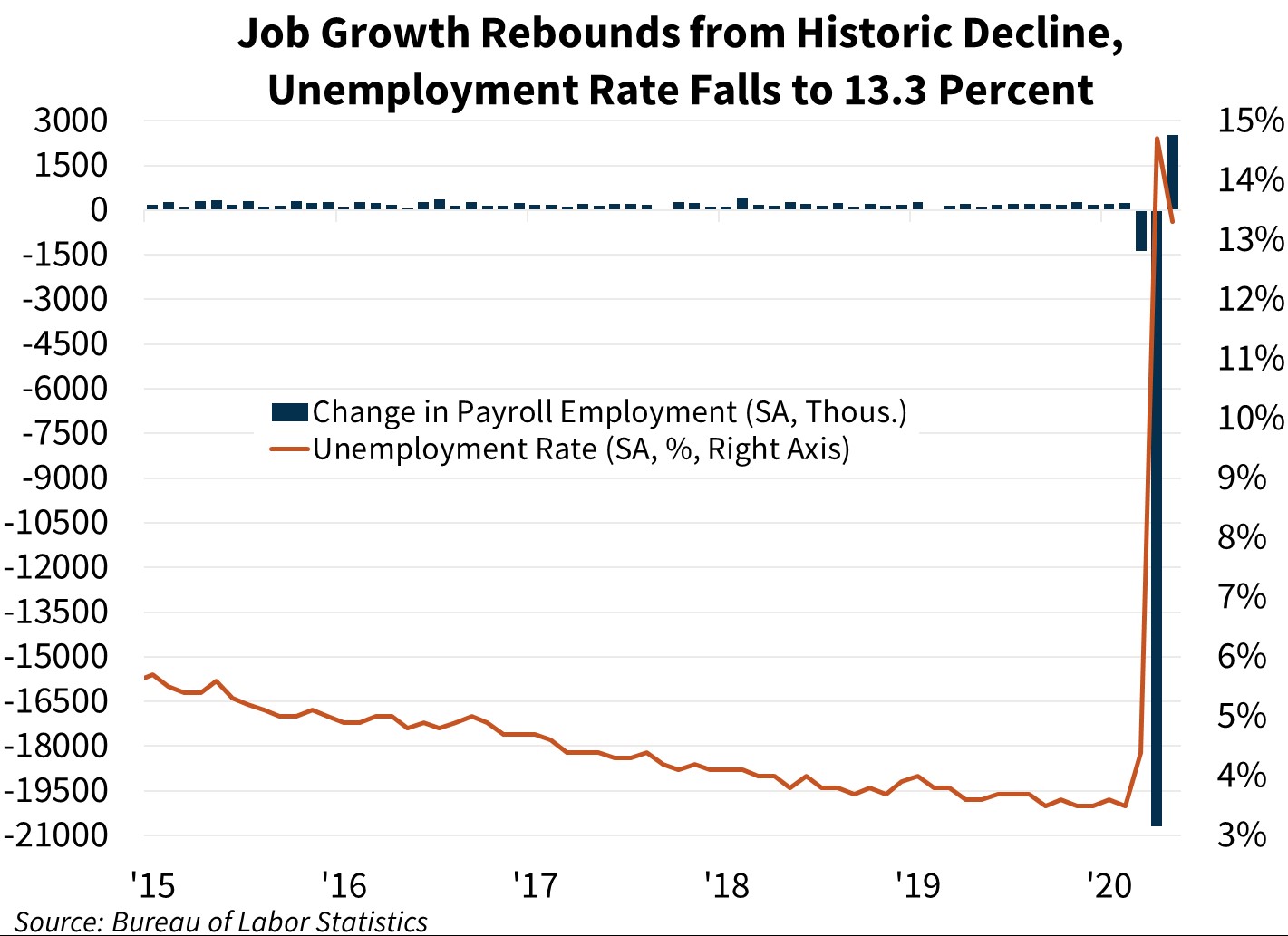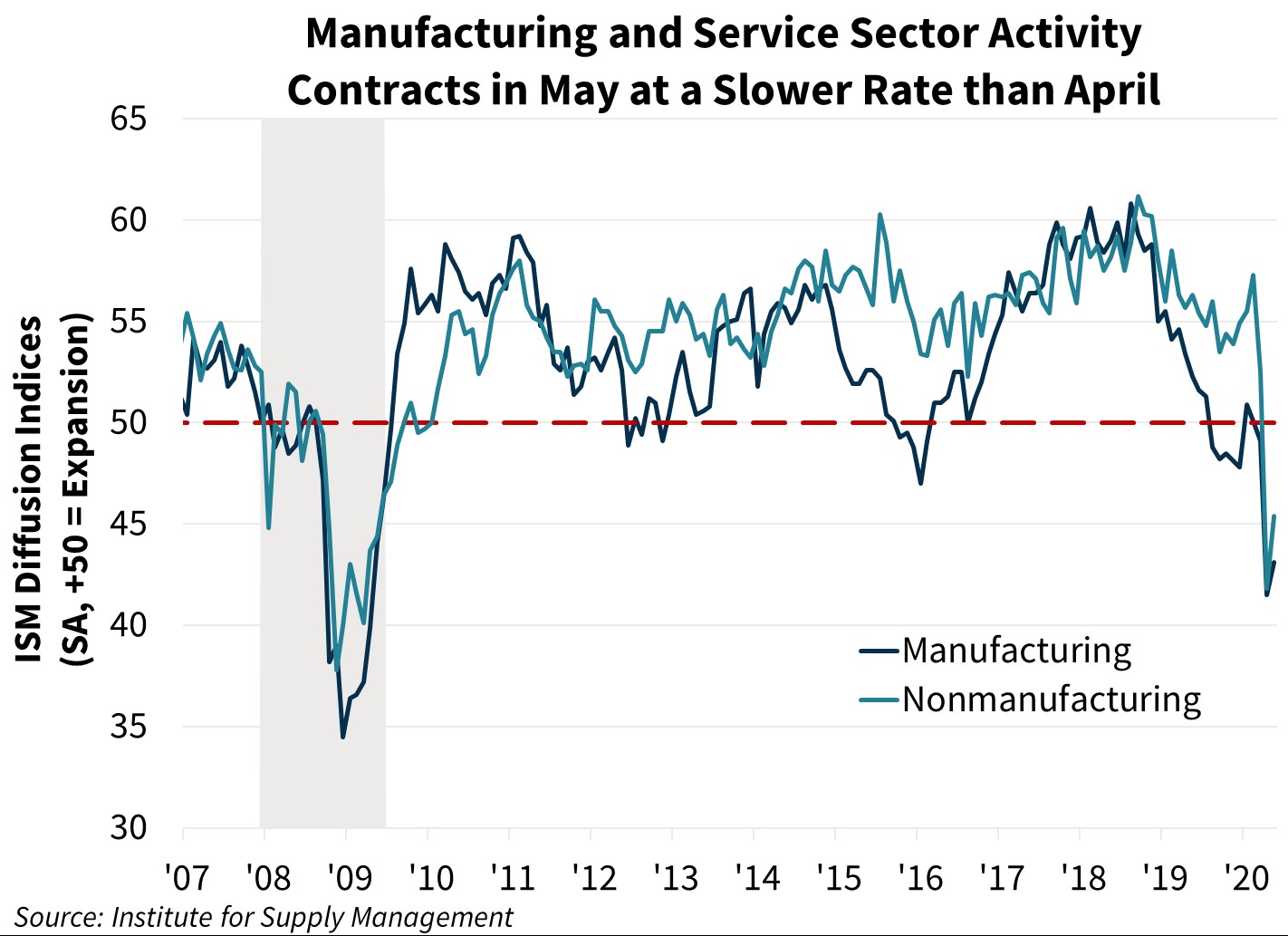Unemployment Posts Surprise Decline in May
Key Takeaways:
- Nonfarm payroll employment increased 2.5 million in May according to the Bureau of Labor Statistics, a small rebound from the record decline posted in April. Although the unemployment rate dropped 1.4 percentage points to 13.3 percent, it remained close to last month’s 72-year high. Average hourly earnings increased 6.7 percent year over year, a slight deceleration from April, likely reflecting a compositional shift in employment back toward hourly wage workers, consistent with the significant job gains in service-producing sectors. Residential construction employment (which includes specialty contractors) increased by 226,000 jobs.
- The ISM Manufacturing Index rose 1.6 points in May to 43.1, the first increase in four months. The indices for new orders, production, and prices posted the largest gains. The ISM Nonmanufacturing Index, a gauge of service sector activity, rose 3.6 points in May to 45.4, the first increase since February. The business activity component jumped 15.0 points, the largest monthly increase since the series began 23 years ago, but still only a partial rebound from April’s steep decline. Any reading below 50 indicates contraction.
- Light vehicle sales jumped 41.5 percent in May to a SAAR of 12.2 million, according to Autodata. Despite the large gain, sales were down nearly 30 percent from the start of this year.
- Factory orders fell 13.0 percent in April, following March’s decline of 11.0 percent, according to the Census Bureau. Transportation equipment orders were hit particularly hard, falling 48.3 percent, the largest decline in series’ history. Orders for nondurable goods fell 9.0 percent, just shy of the record decline from November 2008.
- The U.S. trade deficit widened by $7.1 billion in April to $49.4 billion, according to the Census Bureau. Both exports and imports fell by the largest amount since the series began in 1992, down 20.5 percent and 13.7 percent, respectively.
- Private residential construction spending fell 4.5 percent in April, according to the Census Bureau, the third straight month of declines. New single-family spending dropped 6.6 percent, the largest decline in 11 years. Spending on new multifamily construction also declined sharply, while home improvement spending was unchanged for the month.
Forecast Impact
The May jobs report surprised to the upside following a record-setting decline in April, with even the beleaguered leisure and hospitality sector seeing gains. However, given that the May collection period was at the beginning of the month when reopening measures were limited, it is possible a significant portion of the job gains can be attributed to the impact of the Paycheck Protection Program, which allows firms to bring laid-off workers back onto their payrolls. Regardless, the small rebound was a bright spot in a week filled with otherwise weak economic data. In May, both the manufacturing and nonmanufacturing sectors remained in contraction territory for the third and second straight months, respectively. Combined with two straight months of sharp declines in factory orders, we continue to expect a significant contraction in business fixed investment in the second quarter. The large increase in light vehicle sales in May was a surprise to the upside for consumer spending, though it’s unlikely to offset much of the decline seen in April. For housing, while construction spending fell sharply in April, residential employment rebounded in May, suggesting that home building could improve quickly as states begin to reopen.


Economic and Strategic Research Group
June 5, 2020
Opinions, analyses, estimates, forecasts and other views of Fannie Mae's Economic and Strategic Research (ESR) Group included in these materials should not be construed as indicating Fannie Mae's business prospects or expected results, are based on a number of assumptions, and are subject to change without notice. How this information affects Fannie Mae will depend on many factors. Although the ESR group bases its opinions, analyses, estimates, forecasts and other views on information it considers reliable, it does not guarantee that the information provided in these materials is accurate, current or suitable for any particular purpose. Changes in the assumptions or the information underlying these views, including assumptions about the duration and magnitude of shutdowns and social distancing, could produce materially different results. The analyses, opinions, estimates, forecasts and other views published by the ESR group represent the views of that group as of the date indicated and do not necessarily represent the views of Fannie Mae or its management.
